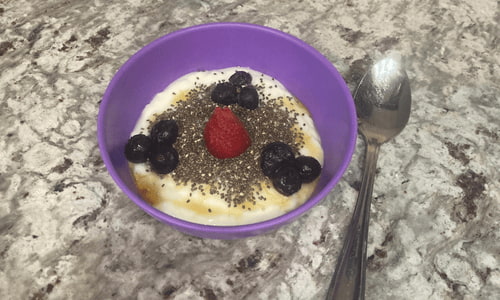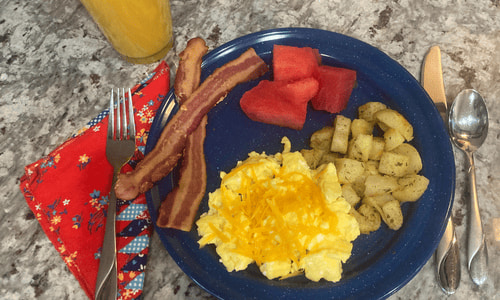Low Volume High Calorie Foods
“Low Volume High Calorie Foods” was written by Amanda Crowe, MS, RDN, CD & edited/reviewed by Aly Bouzek, MS, RDN.
Do you have a low appetite or no appetite? Are you trying to prevent weight loss, maintain weight, or gain weight without having to add a lot of extra food to your diet?
This article provides ways to add calories into your diet without having to eat more food. Check out the recipes below!
What are Low Volume High Calorie Foods?
Low volume high calorie foods are meals and snacks that provide a lot of calories without you needing to eat a ton of food at one time. As delicious as a bag of chips and soda are, they will not be the kinds of foods we will be focusing on in this article.
Instead, we will focus on nutrient-dense foods.
Are Fats Considered a Low Volume High Calorie Food?
Fats contain 9 calories per gram compared to 4 calories per gram for carbohydrates and proteins. All fats are not considered equal. When adding fats into your diet, try to look for foods with unsaturated fats such as olive oil, avocado oil, nuts, or seeds.
Here are some examples of higher fat foods that are also low volume high calorie foods:
- ¼ cup of almonds has 214 calories
- ¼ cup of macadamia nuts has 236 calories
- ¼ cup of pumpkin seeds (without shell) has 207 calories
- ½ cup of dates has 226 calories
- ½ cup granola cereal has 234 calories
- ½ dark chocolate bar (regular-sized, 41 gm) has 216 calories

Nuts and seeds can be a great snack to add into your diet.
Try adding them as a topping to your salad or yogurt.
Oils and butter can be easy to add to your diet as well.
Try using them during the cooking process in a meal, blended up into a smoothie, or added to a dressing to put over vegetables or your salad.
Is Protein Considered a Low Volume High Calorie Food?
Protein is a wonderful addition to a meal or to have as a snack. Protein options not only include poultry, beef, and pork, but they also include dairy products, seafood and fish, nuts and seeds, and eggs.

For example, bacon bits and cheese can be added to an omelet for breakfast, a salad for lunch or a baked potato for dinner.
While it does add a little bit to the meal it will not make the meal so filling that you cannot finish.
Here are some examples of proteins that are low volume high calorie foods:
- 1 whole egg has 72 calories
- 2 slices of bacon have 60 calories
- ¼ cup of shredded cheddar cheese has 115 calories
- 4 oz of salmon has 182 calories
Easy Ways to Add Low Volume High Calorie Foods to Your Diet
The easiest way to add low volume high calorie foods to your diet is to look at what you are already eating. Are there simple swaps that you can make such as protein with a higher fat content or full fat versions of the products you are already using?
Some examples of foods to include: whole milk, full fat Greek yogurt, full fat cottage cheese, chicken thighs, and fatty fish like salmon. Notice how all of these examples are full fat.
Choosing full fat foods is a great way to increase your calories without increasing the amount of food you’re eating.
The next step is to try to avoid foods that say “fat free,” “reduced fat,” “calorie free,” “low calorie,” “reduced calorie,” “light,” or “lite.”
Items that frequently contain these phrases include: salad dressings, crackers, and dairy products. These products can be substituted with full fat/calorie versions from the store. You can also choose full fat ingredients when making homemade foods.
Fortifying Food
Adding low volume high calorie foods doesn’t just include foods purchased from the store. It can also include foods that you fortify yourself. Fortifying a food means that you add nutrients to the food that weren’t there before.
This includes adding/fortifying with calories, fat, protein, or vitamins and minerals. Examples include:
- Adding powdered milk to your whole milk to make Weight Gain Milk
- Adding chia seeds or pumpkin seeds to your yogurt
- Adding hemp hearts to your salad
- Super Cereal
Adding Snacks
If eating big meals is overwhelming when you’re trying to get enough calories, then add in snacks or smaller meals spaced evenly throughout the day.
Low volume high calorie foods can help you get the biggest bang for your buck. Here are some low volume high calorie snack ideas:
- A handful of nuts, seeds, or dried fruit (think trail mix)
- Peanut butter on celery, or apple slices, or crackers
- Ranch dressing or humus added to veggies
- Hard-boiled eggs
- Avocado Toast
Low Volume High Calorie Recipes
Smoothies
Smoothies can be an easy way to start off the day, drink after a workout, or have as a snack while sneaking in those low volume high calorie foods.
Sometimes, drinking calories can be easier than eating them. This 1000 Calorie Smoothie is a delicious way to start your day!
Avocados, coconut milk, half and half, or heavy whipping cream can be added to your smoothies for creaminess. If you have a good blender, then nuts or seeds can easily add some texture.
Small amounts of oil can also be added without affecting the taste or texture. Check out our post on High Calorie Smoothies for Weight Gain for more ideas!
Meals
Adding heavy whipping cream or cream cheese can turn a soup or sauce into a creamy version, adding calories without a lot of effort.
Turn chicken noodle soup into creamy chicken noodle soup, chicken spaghetti into creamy chicken spaghetti, or lemon chicken into creamy lemon chicken.
Coconut rice calls for coconut milk as some of the liquid when preparing the rice. This allows you to add calories without the volume. Coconut rice goes well with Asian food, pork dishes, and marinated chicken.
Pop over to our sister website, High Calorie Recipes – it has more low volume high calorie recipe ideas!
Conclusion
For success when adding low density high calorie foods to your diet, the most important thing to remember is to find foods that are enjoyable to you!
There are lots of low volume high calorie choices out there, so add variety with your choices to keep your meals interesting.
Look for ways to add low volume high calorie foods to what you already eat or change to full fat/calorie items. Add snacks or smaller meals throughout the day if eating bigger meals is overwhelming.
Remember, all the little choices add up over the course of the day.
Talk with your doctor or registered dietitian about any questions you may have regarding changing your diet and how it can affect your health.
References:
- Calorie counts obtained from https://fdc.nal.usda.gov/.
